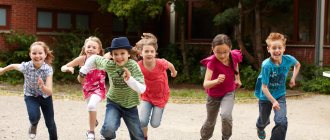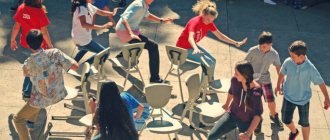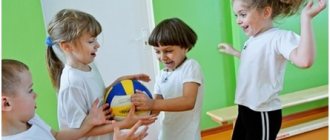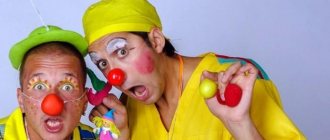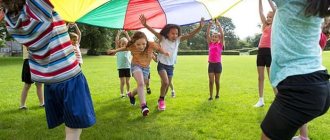Outdoor games, activities and other fun on the school summer playground will help improve children's health, teach children to play and practice in a group, and give a start to the realization of their creativity. Summer holidays are fun, laughter, relaxation and strengthening and improving the health of the children.
I offer you a selection of games and activities for the summer school playground.
Game Golden Gate
The good thing about the game is that children get closer together and get to know each other.
For the game, 2 players are selected among all participants - drivers. One of them is the Moon, the second is the Sun. Then the Moon and the Sun face each other, take hands and raise them, forming a gate.
The remaining players form a chain and run under the open gate. The gates sing and say a rhyme song:
The Golden Gate does not always allow entry:
The first time is forgiven, the second time is forbidden, And
the third time we will never miss it!
At the last words, the Gate lowers its hands and catches the passing player. The detainee is quietly asked which side he would like to take: the Sun or the Moon. He chooses and stands behind the corresponding player.
The rest go through the gate again, and again one of the participants ends up in the sun or moon group. And so on until all participants are distributed.
Then you can use these two teams to play other games, for example, Fun Relay Races or Tug of War.
Games on the summer playground at school; educational and methodological material on the topic
Games on the summer playground at school. Summer camp games
In summer it is very convenient to organize various outdoor games and exercises in the fresh air. Physical exercises in nature are extremely beneficial for improving many of children’s movements and developing their motor qualities. Wide space allows you to move actively, freely, at ease, which contributes to the development of dexterity, dexterity, and endurance of the child. On open lawns, children can move at high speed without fear of bumping into anything.
Every time you go for a walk or plan a trip to nature, think about what games your child will play and take everything you need: balls, ribbons, hoops, etc.
Cowboys and mustangs
Purpose of the game: development of motor, communication and creative abilities.
Attributes: medium sized ball.
Progress of the game: all players are wild horses “Mustangs”; two players are “cowboys”. "Mustangs" stand inside the outlined circle. The “Cowboys” stand opposite each other behind the circle. At the leader’s signal: “One, two, three, catch!” - The “cowboys” take turns throwing the ball at the “Mustangs”, and they try not to let the ball touch them. The Mustang that is hit by the ball is considered caught and tamed. He leaves the circle and is out of the game.
Special notes: Ground balls do not count.
Horse racing
Purpose of the game: development of motor abilities.
Attributes: 4 - 5 chairs or multi-colored flags on stands.
Progress of the game: the players are divided into 2-3 teams and stand behind the line. They are the “horses” participating in the races. Chairs or flags are placed opposite the line. At the leader’s signal, the first “horses” from each team gallop to the chairs or flags, run around them, and return back at a “gallop” - running. Then the second ones run and so on until the last player. The team that finishes the relay first wins.
Special notes: the distance from the line to the chairs is at least 25-30 m.
Horse polo
Purpose of the game: development of motor and communication abilities.
Attributes: 6-7 small rubber balls.
Progress of the game: start and finish lines are drawn on the playground. In the middle of the site, 2-3 circles with a diameter of 0.5 m are drawn at a distance of 1 m from each other. Throwing lines are drawn between the start and finish lines along these circles.
Players are divided into 2 teams of 6-7 people each and line up in columns at the starting line. Teams play in turns, each player holding a small rubber ball. The player of the first team begins to move, pretending to be a horse, along the throwing line and, as he moves, tries to get into one of the drawn circles. He reaches the finish line and stops behind it.
The second player of the first team continues the game, and so on all players in turn. They line up behind the finish line, and the “horses” from the second team come into play. When the game is repeated, all polo participants jump in the opposite direction and line up behind the starting line. Each hit in the circle gives the team 1 point. The team with the most hits wins.
Special notes: the next player enters the game only after the previous one has reached the finish line. Throwing the ball must be in motion.
Threes
Purpose of the game: development of motor abilities.
Attributes: 2 cords lying at opposite ends of the pads.
Progress of the game: all players are first divided into two teams, and then in teams - into three “horses”. Each team stands next to one of the cords. After this, the three players join hands and, at the leader’s signal, run towards each other without releasing their hands.
Special notes: the three that reaches the opposite cord the fastest wins.
Messengers and horsemen
Purpose of the game: development of motor and communication abilities.
Attributes: two flags and a colored ribbon. Progress of the game: 2 lines are drawn on the playing court at a distance of 15 m from one another. 2 flags are placed on one line at a distance of 5 m from each other. Players are divided into 2 teams - “horsemen” and “messengers” - and choose captains. Teams line up in columns, one at a time, at a line opposite the flags.
The captain of the “horsemen” takes the ribbon in his hands. At the leader’s signal, the first team players run to their flag. The horseman’s task is to throw a ribbon at the flag, go around the flag and come back. The task of the “messenger” is to reach the flag, take the ribbon, and on the way back catch up with the “horseman” and shower him with the ribbon. If the “messenger” succeeds, he is considered the winner, and if not, then the “dzhigit” wins. The “messenger”, who has not caught up with the “horseman”, without slowing down, passes the tape to a teammate who is catching up with another “horseman”. The game is played 2 times, changing roles.
Special Notes: Players walk around the flag on the right side. Successive players cannot leave the line before the previous player touches the next player with his hand or tape.
Horses and children
Purpose of the game: development of motor, communication and creative abilities, imaginative thinking.
Progress of the game: all players are divided into 2 teams - children and “horses”. Children pretend to walk through the meadow, pick flowers, and weave wreaths. “Horses” graze nearby. In the words of the presenter:
- Top, top, run away! The horses will trample you!
“But I’m not afraid of horses, I’ll ride along the road!” — several child players begin to imitate horses, jumping and frolicking. Real horse players try to catch them.
Special notes: you can only run away after the word “I’ll get a ride.” The child who is overtaken by the horse is out of the game.
Field hockey
Purpose of the game: development of motor abilities, development of the ability to work in a team.
Attributes: clubs according to the number of players, a small rubber ball.
Progress of the game: a goal is marked in the center on the court on 2 opposite sides. Two players are chosen as goalkeepers, one player is the referee. The rest of the children are divided into 2 teams and are positioned along the field with sticks. At the referee's signal, they try to drive the ball into the goal with the help of sticks. If you manage to score the ball, the game starts over.
Special notes: you cannot form a crowd, push goalies, or swing your stick too much. The referee must ensure that the rules are followed.
Equestrian competition
Purpose of the game: development of motor, communication and creative abilities.
Attributes: colored flags.
Progress of the game: start and finish lines (at a distance of 20-30 m) are drawn on the playing field. At the finish line, several flags are attached at a certain height. All players are divided into pairs - “horse” and “rider” - and stand on the starting line. There are “horses” ahead. They stretch their arms back, and the “riders” take hold of them. In this position, the couples run to the finish line. The “rider,” who is the first to reach the finish line with his “horse,” jumps up and tries to reach the flag attached at a certain height.
Special notes: competitions begin at the signal. The “rider” jumps behind the flag.
Coachman and horses
Purpose of the game: development of general physical abilities and attention.
Attributes: several long colored ribbons.
Progress of the game: players are divided into threes, each three has a “coachman” and two “horses”. The “coachman” controls the “horses” using a colored ribbon. The leader gives various commands during the game, the “horses” carry them out, and the “coachman” controls and carefully watches whether the “horses” perform all the movements accurately. The “horses” walk at a walk, gallop in a circle, turn left, then right, then run back, etc. In response to the leader’s words: “Horses, run!” - the “coachman” lets go of the “reins”, and the “horses” scatter around the playground. To the words: “Find the coachman!” - “horses” quickly run to their “coachman”. The “coachman” whose “horses” make mistakes receives a fine - a white cord is tied to his bright ribbon.
Special notes: when repeating the game in each trio, the “horses” alternately become the “coachman”. The game can be played until all the “horses” have played the role of “coachman”.
Dzhigits and coins
Purpose of the game: development of motor abilities and dexterity.
Attributes: 20-30 small stones.
Progress of the game: start and finish lines are marked on opposite sides of the site. Pebbles and coins are laid out on the site. The players - “horses” - line up along the starting line and, at the leader’s signal, move to the finish line, galloping like horses. During the race, the horsemen, without stopping, pick up pebbles and coins as they go. The winner is the one who was able to collect more coins during the race.
Special notes: during the races, horsemen should not interfere with each other.
Foal and children
Purpose of the game: development of motor, communication and creative abilities.
Progress of the game: all players are children, one of them is a “foal”. Children stand in a circle, and the “foal” is inside the circle. Children walk in a circle, holding hands, and say:
You, red foal,
With a little white tail,
We gave you something to drink
We fed you
Play with us
Hurry up and catch up with us!
After these words, the children scatter in different directions, and the “foal” catches them.
Special Notes: The player who is caught by the "foal" becomes the "foal".
Mountain goats
Purpose of the game: development of motor and creative abilities, dexterity.
Attributes: several medium-sized rubber balls.
Progress of the game: 2-3 “hunters” are selected from all players. The remaining players - mountain goats - run all over the playing area. At the signal, the “hunters” chase them and shoot (throw balls). The greasy mountain goat sits on the ground, the “hunter” runs up to him and touches his back. This means he is caught. The game can be repeated several times.
Special notes: the upset player sits down where the ball hit him. 2 “hunter” players can throw the ball at one player. If the game is played on a playground and many children participate in it, you can select 5-6 “hunters”.
Horsemen's Battle
Purpose of the game: development of motor abilities, dexterity.
Progress of the game: two lines are drawn on the playing court at opposite ends, indicating the start. Players are divided into 2 teams. In each team, half of the players are “horses”, the other half are “riders”. At the command of the leader, the “riders” sit on the shoulders of their “horses”, and they hold the “riders” by the legs.
At the presenter’s signal: “Game!” - all “riders” on “horses” go forward from the start and try to pull the “riders” of the other team from the saddle by the hands. For each “rider” pulled from the saddle, the team receives 1 point, and the latter, along with the “horse,” leaves the game. The game continues until all the “riders” of one of the teams leave the playing field or until the allotted time for the game expires. Then the “horses” and “riders” can change places, and the game continues. The team with the most points wins.
Special notes: “horses” are prohibited from touching players of the other team with their hands, putting their feet on the ground, etc. All violators immediately leave the game.
Orange in the hole
Purpose of the game: development of motor abilities, reaction speed.
Attributes: clubs according to the number of players, medium-sized ball.
Progress of the game: a large circle is drawn on the playing area. In a circle, after 2 steps, they dig holes so that the ball fits into them. In the middle of the circle there is a large hole for an orange ball. All the players have clubs, they stand in their houses. One of the players starts the game. He, pushing the orange ball, tries to get into the central hole, and the rest of the players try to stop him. If a player hits the hole with an orange ball, all the children change places, and the one who hit will try to occupy someone’s empty house at this time. Whoever is left without a house becomes a player and continues the game.
Special notes: You must not move away from your hole while playing.
Home football
Purpose of the game: development of motor and communication abilities.
Attributes: large rubber ball.
Progress of the game: players stand in a circle and join hands. The driver with the ball near his feet is in the middle of the circle. He tries to roll the ball out of the circle with his feet, and the player who passed the ball between his legs takes the place of the driver and goes out of the circle. Players turn their backs to the center. Now the driver needs to roll the ball into the circle. If the ball rolls in, the players again turn to face each other, and the one who missed the ball stands in the middle. The game repeats itself.
Special notes: Players do not handle the ball during the entire game, they only roll it with their feet.
Balls
Purpose of the game: development of motor and communication abilities.
Attributes: large rubber ball, several bats.
How to play: A circle with a diameter of 1 m is drawn on the playground, a large ball is placed in the center. At a distance of 5 m from the circle, players each dig a hole for themselves. The driver stands in the same row with them, but he does not have a hole. Standing near the holes, children take turns throwing a bat at the ball. The ball needs to be kicked out of the circle, but so that it rolls over the line. At the same time, the one who knocked out the ball and the driver run into the field: one to get the bat, and the other to take the hole. If the driver is the first to occupy the hole of the player who knocked the ball out, then he changes roles with him. The player who misses or hits the ball so weakly that it does not roll out of the circle leaves his bat in the field until one of the other players makes a successful hit. Then all the children whose bats are lying in the field run after them. The driver runs after the ball, puts it in the center of the circle, runs to the holes and tries to take one of them.
If none of the players hits the ball, then the driver rolls it along the ground into any hole. The one whose hole the ball hits changes places with him. If the ball does not hit any hole, everything remains the same.
Special notes: When throwing the bat, players should not go beyond the line. The driver should first place the ball in the center of the circle and then occupy the hole.
Circle game
Purpose of the game: development of motor and communication abilities, dexterity.
Progress of the game: 2 concentric circles with a diameter of 1 and 2 m are drawn in the center of the playing area. Players stand along the circumference of the large circle, holding hands. At the leader’s signal, the players begin to move to the right or left in a circle, at the same time trying to pull their neighbors beyond the line of the large circle. To escape, players try to jump over the large circle to get into the small one. The one who gets into the big circle with at least one foot leaves the game.
The players join hands again and, at the leader’s signal, continue the game. If the players break their hands, then they are both out of the game. Those who are not drawn into the circle win.
Special notes: the game starts and stops at the leader’s signal. You can only pull your neighbors into the circle with your hands, without pushing. When there are few players, they stand around a smaller circle and continue the game.
Rain and children
Purpose of the game: development of motor, communication abilities and dexterity.
Progress of the game: on the playground, 2 lines are drawn in opposite directions - home and school, the distance between them is 15-^20 m. The space between home and school is the street. A “rain” driver is walking along the street. All other players - children - are behind the house line. The driver asks the children: “Are you afraid of rain?” The children answer in chorus: “We are not afraid of rain!” After these words, they run across the street to school. The “rain” driver catches those running across. Those caught are eliminated from the game. Then, when all the children get to school, the driver again turns to the children, who, having answered him, run to their house. The game continues until 5 players are caught. After this, a new driver is selected from among the uncaught children.
Special notes: you can run outside only after saying: “We are not afraid of rain!” You cannot run out from behind a house or school and come back. The player who does this is considered caught and leaves the game. To catch means to touch the player with your hand.
Krylova E.V., primary school teacher of the highest qualification. categories
Game Two Lakes
An outdoor game to develop communication skills and attention. To play you need a large field or platform on which you can draw zones.
2-3 players are selected for the game - they will be “hawks”. All other players are divided into “ducks”, “geese” and “swans” so that each group has the same number of players. At different ends of the playing area, three lakes are drawn on which “ducks”, “geese” and “swans” swim.
At the presenter’s signal, the “flight” of players from one lake to another begins. During the game, the “hawks” salute the players. Players caught by the hawks are eliminated from the game.
At the end of the game, you can give a reward to those “birds” who turned out to be the most agile.
Game Fishing Rod or Fisherman
This simple game is loved by both younger and older students. It can be played by a group of different ages.
To play, prepare a rope 2-3 meters long with a weight tied at the end - a bag of sand.
Fisherman is chosen as the reader. He stands with a rope in the center of the circle, which the rest of the players form. The fisherman begins to unwind the fishing rod so that it rotates just above the ground. Children jump over a rope. Gradually, the rope rises higher in the plane of rotation until one of the participants “falls for the bait,” that is, fails to jump over the rotating rope. The caught “Fish” is eliminated from the game.
Game Handkerchief
This is an active game for children of the same age.
A driver is selected from among the children. The remaining players stand in a circle facing each other. The driver takes a handkerchief (it can be any light object) and goes around the circle with it, puts the handkerchief on one of the players’ shoulders, and then quickly runs in a circle.
The player who was given the handkerchief takes it and runs after the driver. Both of them are trying to take an empty seat. If the driver takes a seat, then the player becomes a wada.
Competitions for schoolchildren 2020-2021
We present to you a list of the 10 most significant all-Russian competitions for high school students. We have prepared a small material with free competitions and opportunities for high school students this year. If you have any additions, write in the comments.
